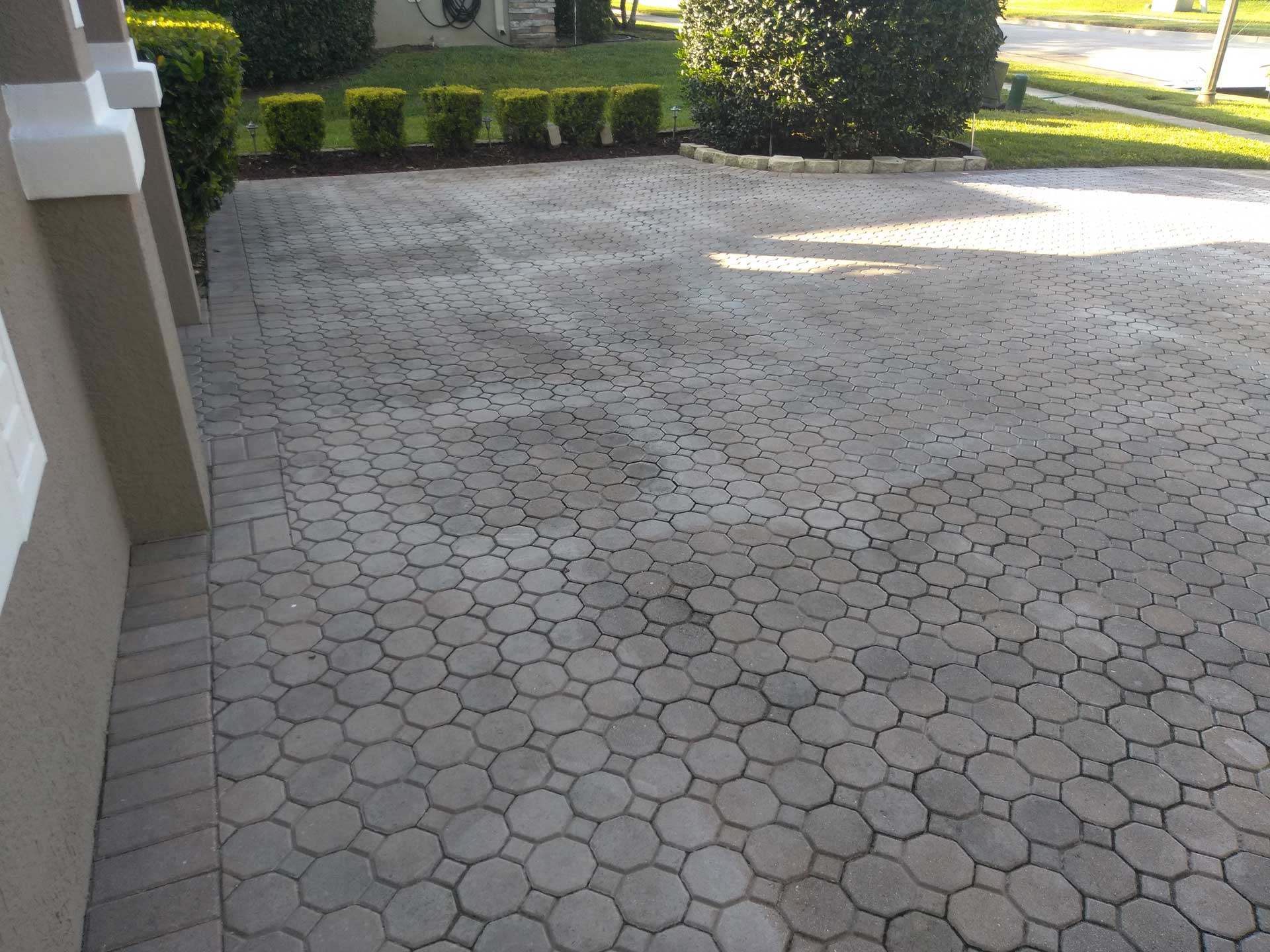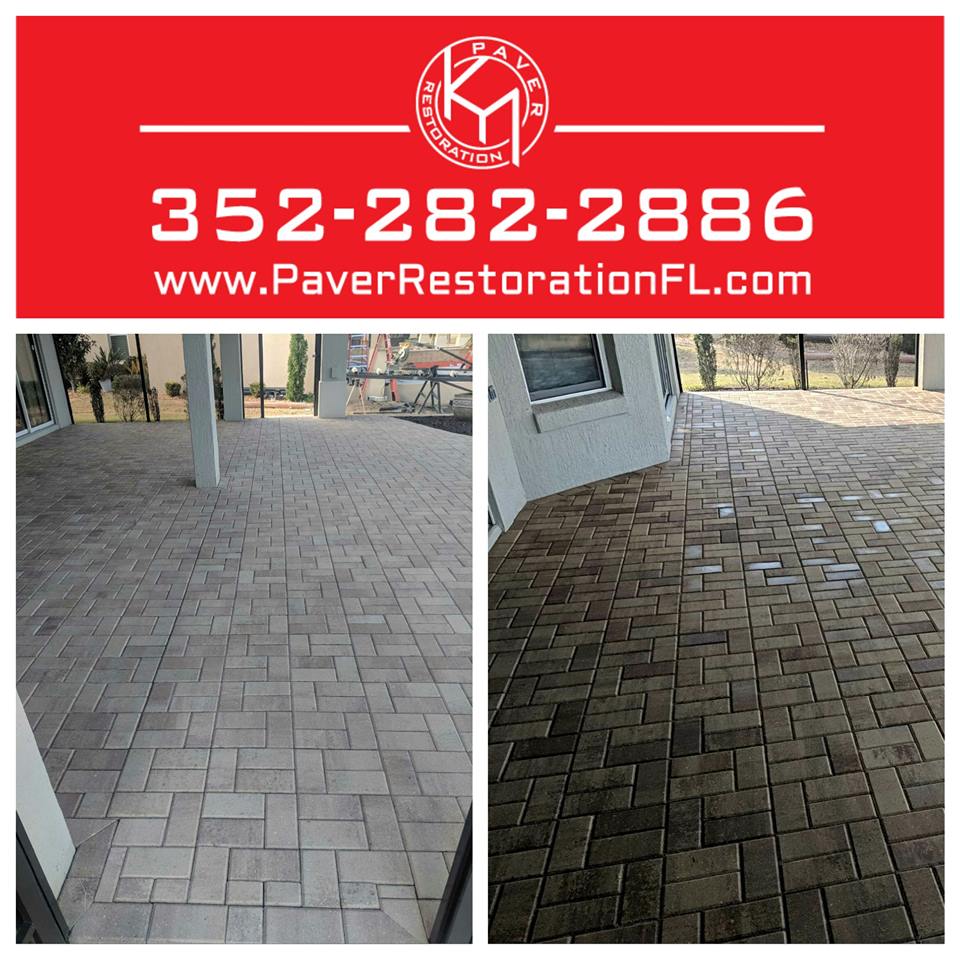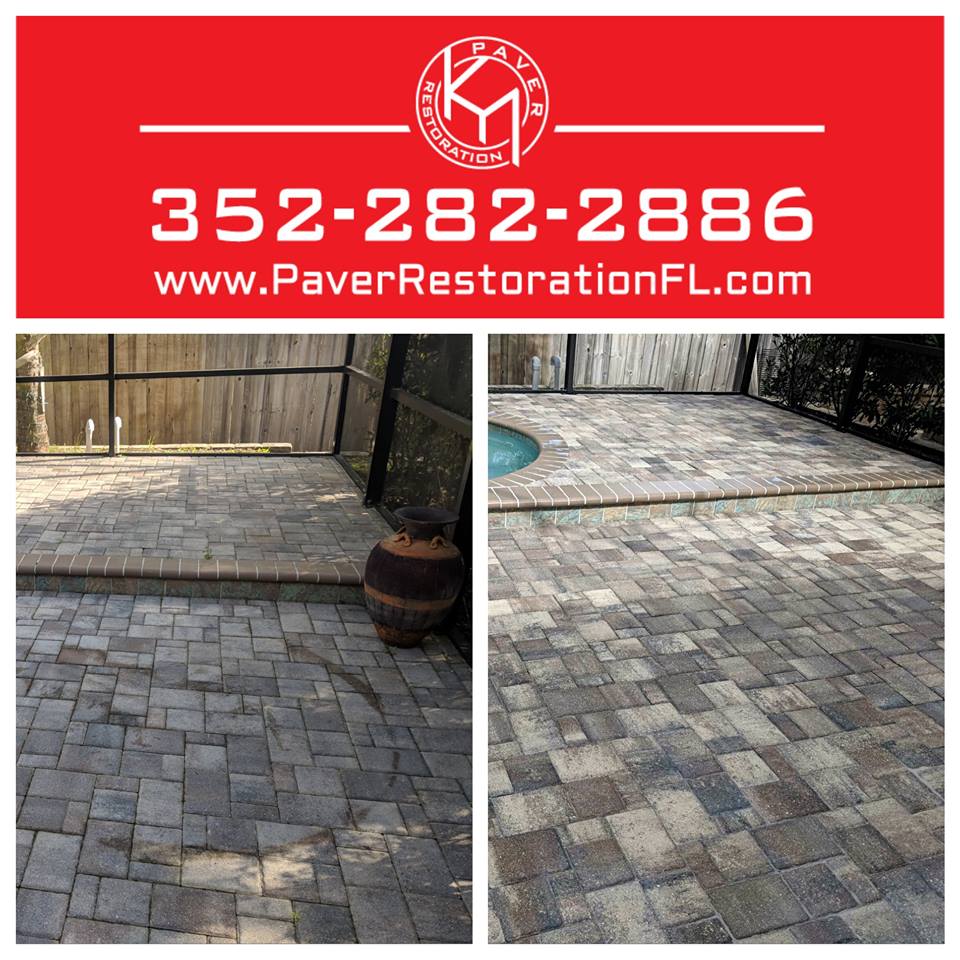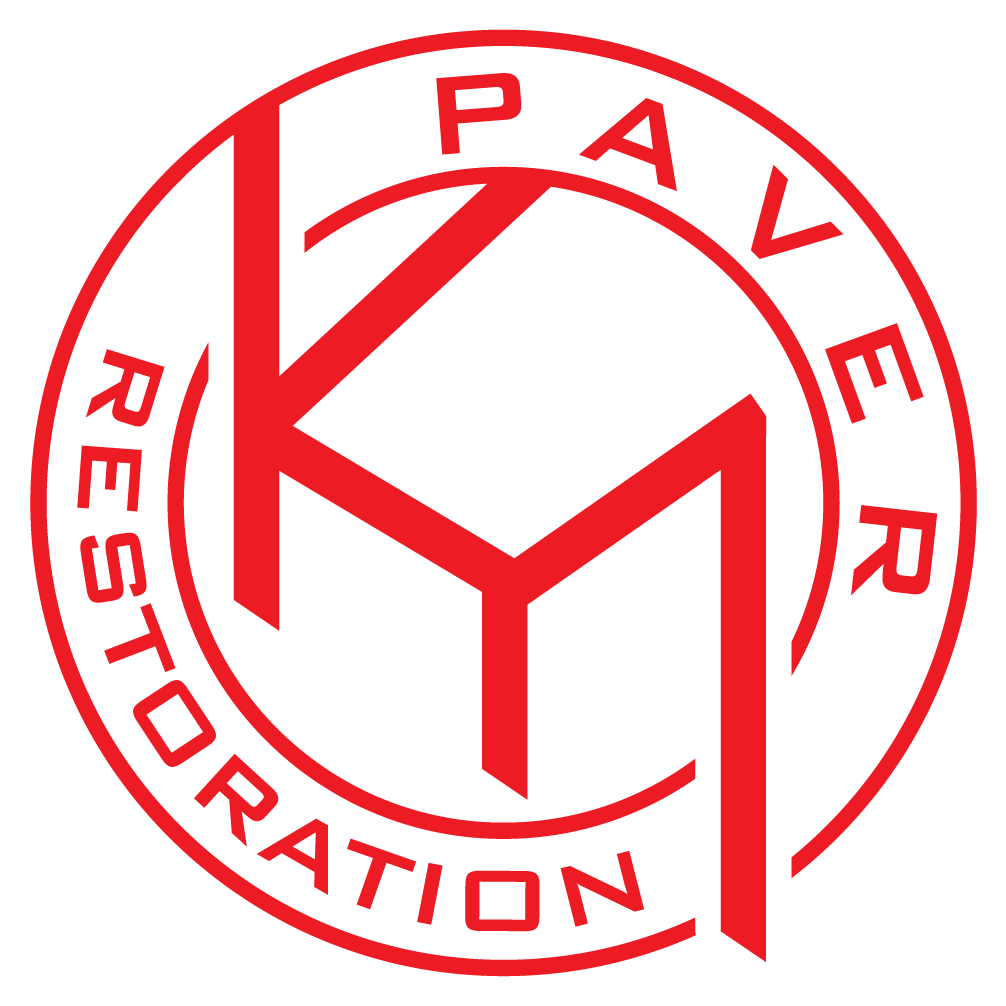Brick Paver Restoration
As a significant part of our business, brick paver restoration covers a broad range of services, such as stripping off failed paver sealant, calcium removal, oil stain removal, rust/irrigation removal, rust/fertilizer rust removal, efflorescence removal, and color restoration.
*Since 2020, some pavers that have been manufactured have not fully cured out correctly and contain some iron deposits in the stone itself, plus many are still green and need longer to cure out after installation.
There are cheap bricks with impurities in the sand mix during the manufacturing process, coupled with a horrible base. This less-than-adequate base creates this calcium build-up.
Always Remember: Cheaper isn’t better, not in the long run, as it may cost you four times the original cost of doing it right the 1st time.
The Stripping Process


Stripping of brick paver sealant is needed when an inexperienced contractor or overzealous employee is in a rush or doesn’t fully understand how to clean and seal pavers properly.
A homeowner, handyman, or even a paver installer often uses a cheap or low-quality paver sealant. Often, we find ourselves removing solvent/oil/xylene/acrylic-based paver sealants, which are all different names for the same product. How could one product have multiple names? A solvent simply means “to dissolve” and is a very toxic paver sealer often composed of xylene for the brick paver application process. The xylene composition makes it an acrylic type of sealant. Often, acrylics are referred to as oils.
Homeowners will often hear that a contractor used a solvent-based sealant on their pavers, and it turned white, and the contractor will then say, “Oh, well, we use a xylene-based or an oil-based sealer” in hopes of making the uneducated homeowner think it’s a different product. While these types of sealants are perfect up north, here in our West Central Florida service area, there is too much moisture in the ground for these paver sealants to have a positive outcome. If you draw a line from Marion County to Daytona, everything south of that line falls under Florida’s humid subtropical climate category. What happens in these areas especially is that the moisture we have in the ground permeates through the ground soil first, then through aggregate paver base material, and finally into the porous brick pavers. When inside the brick pavers, moisture gets trapped between the paver and the thin top layer coating of those solvent-based sealants mentioned above, not allowing them to breathe and creating a hazy white look.
Stripping can also be effective when an installer previously sealed in the dirt or other contaminants or over-sanded the pavers with incorrectly sanded joints. It’s important to note that our standard cleaning service will remove any dirt, mildew, or contaminants on your pavers unless they are under your current sealer. At that point, stripping is most likely needed.


What Are My Paver Restoration Options?
Solvent-based brick paver sealants must be applied when the brick pavers are COMPLETELY DRY – free of ANY immediate moisture. As previously mentioned, there is too much moisture in the ground in this region of Florida to have the ideal paver sealing conditions for 8 out of 12 months of the year. As a result, these sealants will begin to turn a hazy white color (often within the first three months or the first few rainfalls) and, in some extreme cases, even look like someone spilled caulk or white glue into the joints and across the surface of your once beautiful brick pavers!
You have a few paver restoration options, but there is only one truly cost-effective option:
- Replace the entire driveway, patio, walkway, etc., at an extremely high cost
- Live with ugly pavers, hoping they will wear off in about 7-9 years.
- The best and most cost-effective option is to have the failed paver sealer stripped off the surface and re-sealed correctly.
Permanent Color Enhancement For Brick Pavers
Brick paver color restoration is a service we provide at a small additional cost per square foot. We mix in a pigmented stain with our coats of brick paver sealer. The tint we use is directly from the manufacturers at Innovative Concrete Technologies (the manufacturer of UreSeal H2O) and is only available to very few of the selected, trained, and certified contractors. It is a permanent tint that does not wear off and will remain with your brick pavers permanently.
It is not a coating that covers the pavers entirely but a semi-translucent additive we are adding that enhances the color while still showing the patina and contrast of the brick pavers. Our coating options include canyon brown, desert gold, red clay, slate black, barnacle, sage green, saddle tan, granite gray, emerald green, coral dust, brick red, and nautical blue. For best practice, we recommend choosing a color that resembles your prominent paver color for ideal enhancement. Contact us for more details on a color restoration!



Brick Paver Rust Removal
Rust on brick pavers is commonly found on properties with yard irrigation from a well system. Irrigation rust is an ugly and frustrating problem. Rust is also widely seen where fertilizers have been sprayed on a lawn and over-spray was left to sit on concrete or brick pavers. In most fertilizers, you will find iron. Although iron is very healthy for grass and plants, this isn’t the case for pavers. When left to sit on brick paver surfaces, rust begins to grow and soak into the pores of the brick pavers. In addition to fertilizers, we often find rust stains on brick paver pool decks from BBQ grills, metal patio furniture, or planters.
We have products capable of lightening and removing irrigation rust, fertilizer rust, and patio furniture from all your brick paver surfaces. Contact us today for a free estimate! If you insist on sealing your pavers yourself or are a new contractor, feel free to call us for professional advice and guidance along the way with your brick paver restoration.

What is Efflorescence?
There is a chance that after a few weeks or months pass, a white haze may appear on the surface of your pavers. This is known as efflorescence. It may appear randomly or in certain areas and be more pronounced on dark-colored pavers. The white haze may give the impression that the paver color is fading. When the pavers are wet, the white haze disappears, and the color of the pavers is enhanced; however, when they dry, the white haze reappears.
There is no reason to be concerned that your pavers are damaged or defective as they go through a natural process. It is a condition that occurs in all cement-based products and many other paving products. The condition will usually correct itself with time and exposure to the elements. If you live in an area of frequent rainy and sunny days, efflorescence and its passing may occur quickly. However, this process may take much longer in drier climates.
Can Efflorescence Be Removed Without the Wait?
Efflorescence may be cleaned with commercially available cleaners explicitly formulated for concrete pavers. Cleaning should be performed immediately after efflorescence has appeared, although it may reappear if the chemical reaction continues. In this instance, cleaning may need to be done until efflorescence has stopped.
Most cleaners contain acid and detergents, so follow all label directions and environmental regulations. Careless or improper cleaning can result in injury, damage, and discoloration to the surface of the concrete pavers. Always test in a small, inconspicuous area before applying any cleaner to the entire concrete pavers area. Contact us today if you have any questions about what cleaners should be used or the efflorescence process in general.
Our Treatment Practices
Adhering to proper wash water recovery and treatment practices is a moral obligation to the environment and a legal requirement. The Environmental Protection Agency (EPA) and other agencies fine and penalize companies that do not adequately invest in wash water recovery treatment. The EPA requires businesses to adhere to standards, often including implementing a wash water recovery and treatment system. We have implemented wash water control during our brick paver restoration process to ensure adherence to the EPA’s standards. One of our core practices is to dispose of all stripped sealers offsite.
One practice we tend to avoid is tinting Damaged Pavers as tinting is not recommended to fix damaged or poor sealant as the sealer is translucent.
Customers understand tinting is translucent.
Another practice we adhere to is protecting nearby objects from stripping and sealants. Below is a picture of a bocote front door we protected before stripping a poor sealing job from another contractor. Before stripping, remove all potted plants and other sensitive objects. We protect all doors, walls, and enclosures.

Our Estimate Process
Nearly 90% of our estimates can be given based on a satellite imagery program, which allows us to take near-exact square footage measurements of your driveways or pool decks and patios. This lowers our overhead expenses as we can give quotes with this program, which saves time and money for you altogether. Most quotes will be emailed to our customers within 24 hours of the request with a very detailed description of our process and links to all of the products we will be using.
